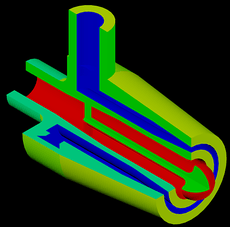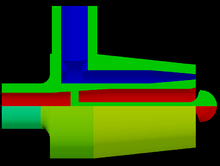Pintle injector
A pintle injector is a type of propellant injection device for a rocket engine that was first used on a flight vehicle during the Apollo Program in the Lunar Excursion Module's Descent Propulsion System. Pintle injectors are currently used in SpaceX's Merlin engines.
History
The origins of the pintle injector were early laboratory experimental apparatus, used by Caltech and JPL in the mid-1950s, to study propellant mixing and combustion reaction times of hypergolic liquid propellants. The pintle injector was reduced to practice and developed by Space Technology Laboratories (STL), then a division of Ramo-Wooldridge Corp., later TRW starting in 1960; however, it was not until October 1972 that U.S. Patent 3,699,772 for invention of the pintle injector was granted to Gerry Elverum, of TRW and made public.[1]
Description

A pintle injector is a coaxial injector. Propellant stream A (fuel or oxidizer) flows through an outer tube, coming out as a cylindrical stream, while propellant stream B (complement of A) flows in an inner tube and impinges on a pintle shaped similarly to a car-engine poppet valve, which causes B to spray outward in a broad cone or flat sheet that intersects the cylindrical stream of propellant A. In some variants the pintle has grooves cut into it to produce radial jets in the flow of propellant B.[1]
If propellant B is the fuel and A the oxidizer, the pintle arrangement can be set up to get fuel-film cooling of the inside of the combustion chamber essentially automatically; also, pintle injectors allow deep throttling without large losses in combustion efficiency. Pintle injectors also avoid acoustic combustion instability, and therefore have an excellent safety record.[1] (Many people have experienced throttleable pintle sprayers in the form of standard garden hose-end sprayers.[2])

References
- 1 2 3 Dressler, Gordan A.; Bauer, J. Martin (2000). "TRW Pintle Engine Heritage and Performance Characteristics" (PDF). AIAA. AIAA-2000-3871. Retrieved 4 June 2012.
- ↑ Fischer, Dave. "Pintle Injector Rocket Engines". National Space Society Blog. National Space Society. Retrieved 2013-08-15.
